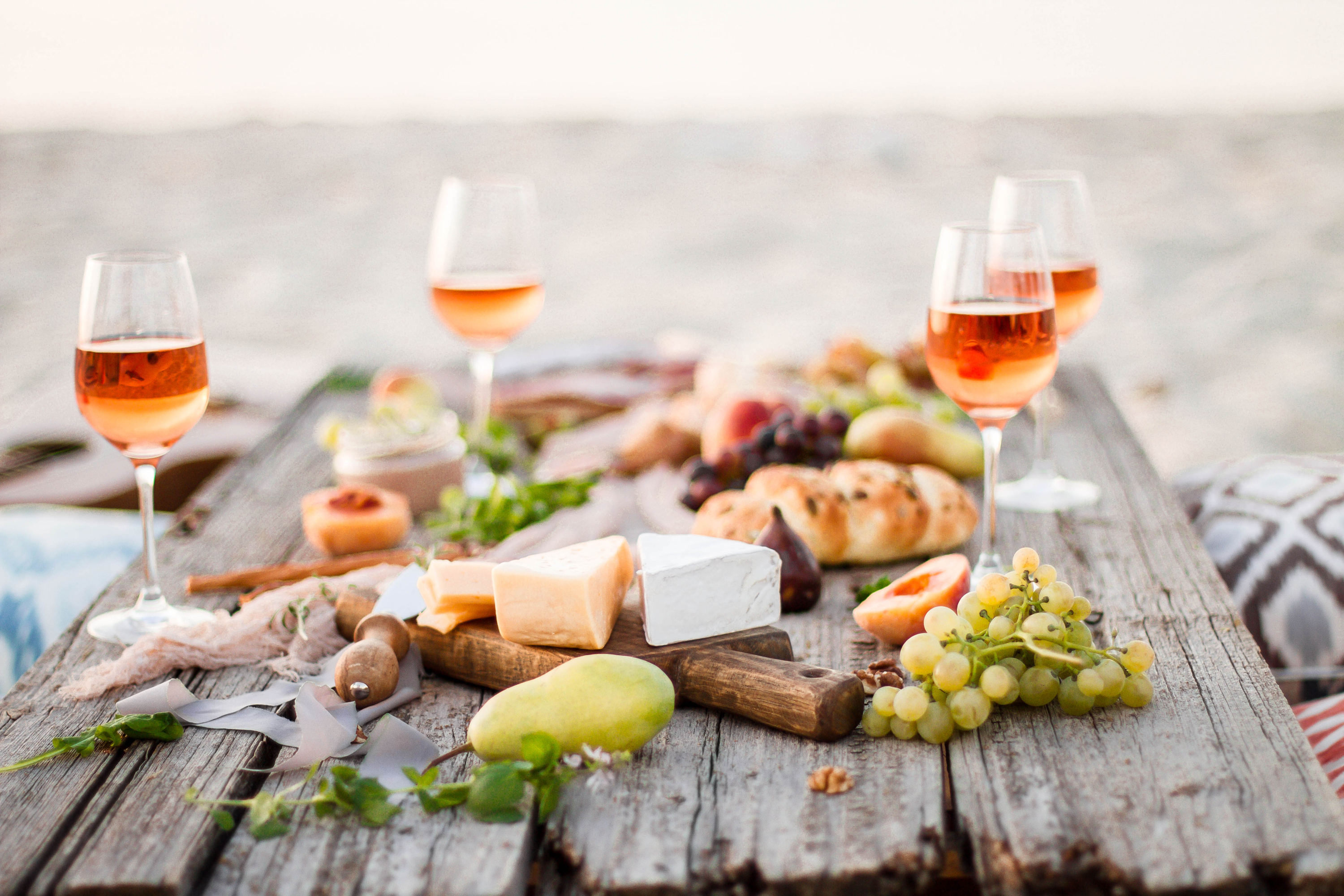Cheeseboards are the ultimate lazy meal solution – especially in summer. When you’ve spent the day at the beach, just arrived back from holiday, or have spent the weekend barbecuing up a storm, sometimes the last thing you want to do is cook – no matter how much you love being in the kitchen.
Stocking up on a few of your favourite cheeses, with drinks, snacks and sides to match alongside, means a ‘picky tea’ or lunch can be ready in a flash, leaving you free to slip into your sandals and sunnies, and put your feet up.
A single, perfectly ripe, carefully chosen cheese you love will do the trick if it’s just you or two of you for tea. If you’re catering for a crowd, go for five to six different cheeses including a hard style (like Cheddar), something soft and bloomy, a washed rind, a blue, and a sheep or goats’ milk variety.
Here's just a few suggestions to get you started.
The best cheeses to serve in summer
Farmhouse Cheddar
There are so many types of Cheddar to choose from (mild up to vintage) but at this time of year we like to roll out farmhouse versions. They tend to be a touch juicier inside, with a piquant, almost fruity flavour running through.
Perfect pairings: It sounds strange, but hear us out – match farmhouse Cheddar with mango chutney. This clings onto the almost tropical fruit notes in the cheese, taking the flavour to the next level. Pieces of dried mango will do the trick too, as will chunks of fresh pineapple – there's a reason pineapple and cheese on sticks have been a party favourite for decades, you know!
What to drink: Cold, crisp cider. The two go hand in hand. For this type of Cheddar steer yourself towards the sweeter end of the scale.
Manchego
Bring the tapas experience home with this cheese, ubiquitous across Spain. The best is made purely with sheep’s milk, and it’s available soft (15 days matured) to aged 12 months or more, which will be supple in texture, but with a sweet, savoury bite.
Perfect pairings: For simplicity, toasted almonds (traditionally Marcona) sprinkled with sea salt are heavenly with Manchego, as is quince paste (membrillo). Across Spain Manchego will be served with a wide range of typically fruity preserves – usually marmalades made with oranges, apricots, plums and figs. Look for a variety made locally to you.
What to drink: Lightly chilled Rioja or Garnacha are great fits if you like red wine. Otherwise, try a delicate fino sherry, oaked Chardonnay, or Verdejo.
Aged Gouda or Old Winchester
The powerful, spicy bite of matured Dutch Gouda (or its British equivalent), has made it a must have for cheese lovers. It delivers a real punch.
Perfect pairings: This style of Gouda lingers, and has remarkable complexity that switches between fruit, spice and nuttiness. It’s a superb partner in crime alongside chunks of smoked ham, or slivers of Alpine style ham (such as Speck), and goes very well with walnuts. We also love it with a feisty chilli jam.
What to drink: Robust red wines like Barolo suit this cheese style very well, otherwise choose beer. Trappiste varieties and darker ales rather than lager. Sharp apple juice fits the bill too.
Brie & Bloomy Rinded
Many Bries and Brie-type cheeses share similar characteristics, being squidgy and melting under the rind, with a slightly chalky, firmer heart. They’ll be earthy, mushroomy and sometimes a touch meaty. Give them two hours at room temperature to come to life in summer.
Perfect pairings: Ripe strawberries, and even a dollop of strawberry conserve play well with these cheeses in summer, as do dark cherries and plums. They are also magnificent with warm, crusty, yeasty white bread, so head to your local bakery for baguettes, or serve with a heat-at-home version.
What to drink: Crack open the Cava, Prosecco, Champagne or sparking English wine. These plump, fatty cheeses need something sharp and bubbly to cut through each bite.
Cream Cheese
Butter boards were all the rage last year, but the same visual impact can be made with cream cheeses, scooped straight from the pot.
Perfect pairings: Smear cream cheese across a section of your board, creating a little dip or ‘pool’ in the middle for your seasonings. Edible flowers (violas, marigolds, chive flowers) with honey look stunning and are sensational with sheep’s milk or lighter goats’ cream cheeses. Or snip in fresh chives and soft herbs, or chopped red chillies and coriander. Serve with baby carrots, mange tout, and summer radishes.
Milder, unsalted cream cheeses can come out for dessert too, stirred with a little cooled, melted chocolate and topped with fresh berries.
What to drink: Like Brie, cream cheese favours bubbles, or go for a minerally, flinty, well chilled white wine such as Chablis or Sancerre.
Crumbly
Feta, Cheshire and other crumbly textured cheeses have a fresh, lactic sharpness that makes them central to summer eating, and they can be treated in much the same way across the cheeseboard.
Perfect pairings: Watermelon and Feta are innately good together, marrying sweet, sharp and salty. Cheshire and White Stilton will enjoy sidling up to melon on the cheeseboard too. Throw over a few toasted, salted pumpkin seeds to up the ante. These cheeses adore tomatoes as well – but they must be ripe! Warm your finest toms in the sun, slice, season, dress with oil and vinegar, and serve on a platter topped with chunks of crumbly cheese and a few leaves of oregano.
What to drink: Greek Assyrtiko or Xinomavro wines are a joy with these cheeses, bringing much-needed acidity.
Washed Rind
Epoisses, Langres, Stinking Bishop, Oxford Isis – all these cheeses have one thing in common – they’re on the pongier end of the spectrum. Their bark is (usually) bigger than their bite, though, so don’t be put off!
Perfect pairings: If washed rinds are your ‘thing’ you might just like to let the cheese do the talking, serving it simply over a neutral sourdough cracker. But we prefer to funk things up. Here is where those ferments come into play. Bread and butter pickles and dill pickles are a dream with any washed rind, as is kimchi. Experiment! The meatiness around the edges of these types of cheeses calls for charcuterie too – making them a powerhouse on the summer grazing board.
What to drink: Naturally fermented and sour beers are epic with these cheeses. Langres calls for Champagne or sparkling wine to be poured into its concave middle. Or invest in a really good bottle of kombucha.
Blue
We’ve got a few suggestions when it comes to summer blues. If you can get hold of it, a pot of Gorgonzola Dolce, scooped directly from the wheel by a cheesemonger, is a thing of beauty. Failing this, Germany’s award-winning soft, dreamy Montagnolo, with its thick ribbons of blue veining, also has the lighter touch. Or for bite, it has to be English Stilton, or one of the fabulous Italian Ubriaco blues, soaked in wine or spirits.
Perfect pairings: Orchard fruits and figs are a classic match for blue cheese, but summer has plenty to offer too. The tannic sweetness of fresh blueberries or blueberry preserve brings loads to the party with stronger blue cheeses. Chilled cherries or cherry jam are superb with scooping Gorgonzola. And have you tried blue cheese and chocolate? You can make a surprisingly delicious summer canape by topping a digestive biscuit with a slice of blue, a grating of the darkest chocolate, and a small spoonful of dark fruit jam.
We also highly recommend seeking out some local honey. A spoonful glistening over a wedge of blue cheese is absolutely heavenly.
What to drink: If you’ve never tried mead before, perhaps now’s the time to try it. Made by fermenting honey, without any added sugars, it’s an aromatic, heady accompaniment to blue cheeses served chilled in summer, or warm in the cooler months. Red wine can muddy the flavour of a decent blue, so stick to lighter bottles, such as Pinot Noir, or go for sparkling English wine, or sticky, sweet dessert wines like Hungarian Tokaji.
What do you need for a summer cheeseboard?
1. Always include ripe, seasonal fruit - from the first early strawberries, to late summer’s plums and peaches. Build your board around the season’s bounty to make it truly special.
2. Switch up your sides – replace darker, richer chutneys with fruitier, lighter options – from mango to apricot.
3. Ferments are your friends – kimchi, cucumber pickles, sauerkraut and other fermented foods are magical with cheese and bring a crisp, bright crunch to the cheeseboard.
4. Create a seasonal fondue centrepiece. Left at room temperature for a few hours (out of the sun) many soft cheeses will naturally transform into gooey dips for dunking crudites and bread. We’re talking soft blues, Bries and Camembert styles. Also look out for the Spanish Torta del Casar, which is gorgeously sspreadable after just 45 minutes to an hour out of the fridge.
5. Unless you’re eating it immediately, bread will dry out very quickly alongside a summer cheeseboard. Resolve this by either keeping bread whole until eating, or by covering cut bread with a damp (but wringed out) tea towel.
What's the best type of board to display cheese in summer?
The most distinctive way to present cheese is on a rustic wooden board – ideally walnut, maple, cherry or oak. Ensure it’s food safe. And remember, these will split over time if you immerse them in water, so clean with a cloth and food safe antibacterial spray rather than dunking in the sink or dishwasher. And ‘season’ regularly by rubbing down with oil or beeswax.
If you’re worried about germs, slate and marble are perfect options.
Top tip: Keep your display cool by chilling your cheeseboard in the fridge overnight (without cheese). This works best with slate, marble, china and porcelain.
Which cheeses are the best for picnics?
Taking cheese out on a picnic? Make sure it’s wrapped in either double-lined cheese paper (available online and from specialist cheese shops) or foil. Clingfilm should be a last resort – it will make all those lovely cheeses sweat, and nobody wants that!
Carry cheese in an insulated bag with an ice pack, wrapping this in a tea towel so it doesn’t directly touch any of your goodies.
The most portable cheeses: Waxed truckles, Cheddar, Parmesan, Pecorino, Gouda, Alpine styles (Beaufort, Comte, Emmenthal, Le Gruyere), smaller washed-rind cheeses (Langres), individually boxed soft cheeses (Camembert, Brie).


